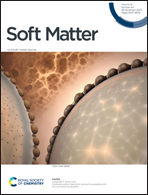Close packings of identical proteins in small spherical capsids and similar proteinaceous shells†
Abstract
Understanding the principles governing protein arrangement in viral capsids and structurally similar protein shells can enable the development of new antiviral strategies and the design of artificial protein cages for various applications. We study these principles within the context of the close packing problem, by analyzing dozens of small spherical shells assembled from a single type of protein. First, we use icosahedral spherical close packings containing 60T identical disks, where T ≤ 4, to rationalize the protein arrangement in twenty real icosahedral shells both satisfying and violating the paradigmatic Caspar–Klug model. We uncover a striking correspondence between the protein mass centers in the considered shells and the centers of disks in the close packings. To generalize the packing model, we consider proteins with a weak shape anisotropy and propose an interaction energy, minimization of which allows us to obtain spherical dense packings of slightly anisotropic structural units. In the case of strong anisotropy, we model the proteins as sequences of overlapping discs of different sizes, with minimum energy configuration not only resulting in packings, accurately reproducing locations and orientations of individual proteins, but also revealing that icosahedral packings that display the handedness of real capsids are energetically more favorable. Finally, by introducing effective disc charges, we rationalize the formation of inter-protein bonds in protein shells.



 Please wait while we load your content...
Please wait while we load your content...